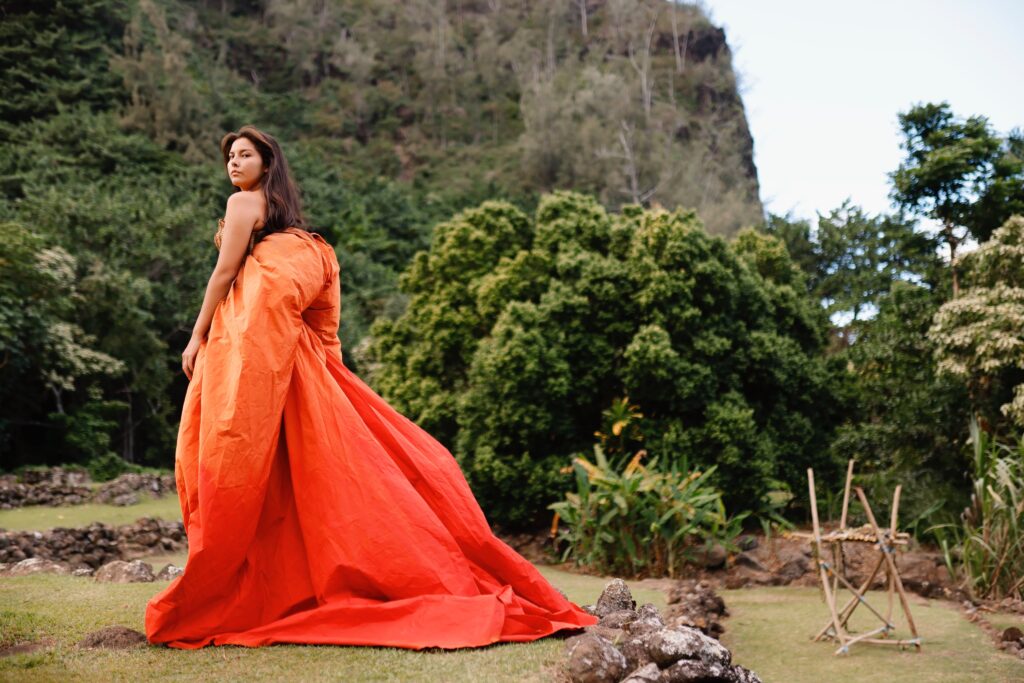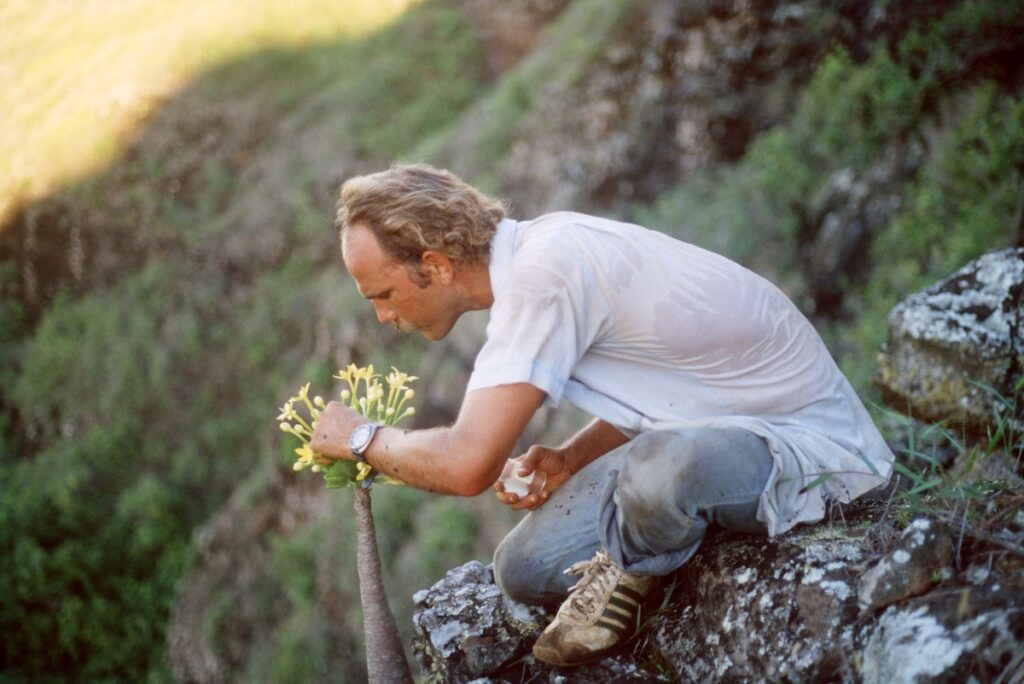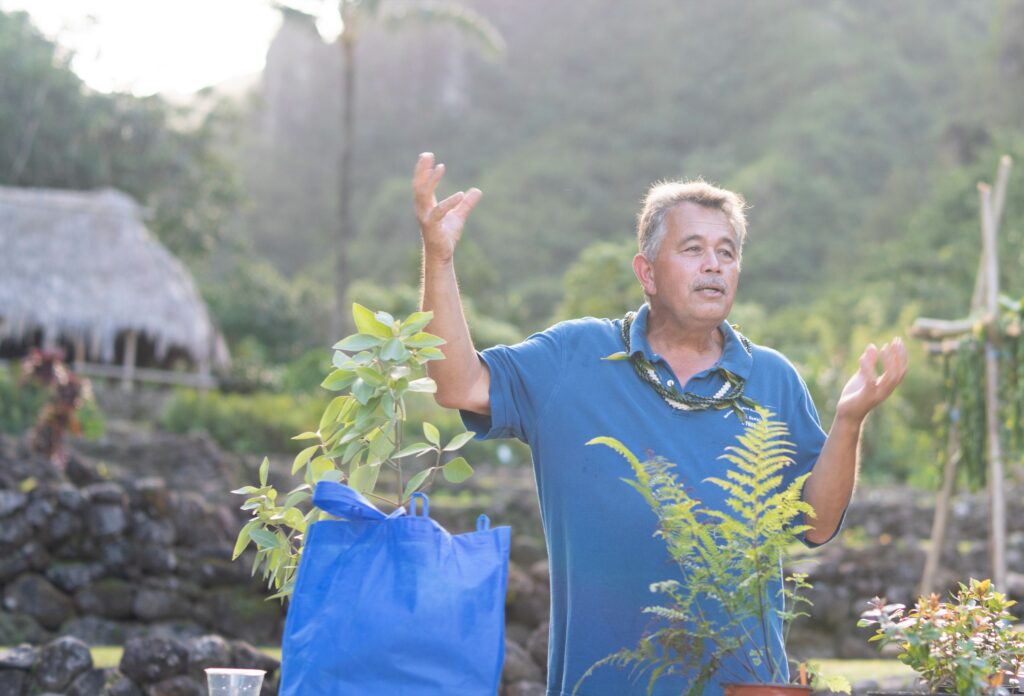By David Bryant, Director of Communications
Nani wale nā hala ʻeā ʻeā o Naue i ke kai ʻeā ʻeā …so begins Nā Hala O Naue, a famous ode to a cherished grove of hala (Pandanus) trees that once shaded Naue Beach on Kauaʻi’s North shore. But today this forest “drenched in fragrance” and “swaying close to Hāʻena” has been all but lost.
The iconic hala tree spirals skyward atop stilt-like roots, their leaves exploding in tropical rosettes. These leaves are literally woven into Hawaiian culture, used for sails, baskets, apparel, and much more.
Hala’s chunky yellow, orange, and muted brown fruits add to the plant’s flamboyance. But it’s the elegantly small, red fruit for which Naue hala is renowned.
What happened to the beloved hala grove of Naue? Siblings Violet Hashimoto-Goto and Thomas Hashimoto, born in Hāʻena in the 1930s, say many of the trees were destroyed by a tsunami in 1946. NTBG’s former president Chipper Wichman adds, “When I was growing up, the tidal wave of 1957 had just occurred and Naue had been completely flattened. The combination of the two tsunamis did indeed wipe out all that remained of the hala grove at Naue.”
Lei Wann, director of Limahuli Garden and Preserve, whose family is from Hāʻena, has spent decades in search of the elusive Naue hala. For her, reviving these trees is a vital component of preserving her community and culture. “These plants hold stories and reawaken our genealogical connections,” says Lei. “They are living artifacts that transcend time and weave our stories together.”
(L) Lei Wann, director of Limahuli Garden and Preserve. Photo by Erica Taniguchi. (R) The red fruit of the Naue Hala.
Growing up, Lei heard murmurs about Naue hala still found in backyards and in memories. These leads would surface, only to vanish. There was fear that the famed red hala of Naue was forever lost.
When Lei celebrated her son Hanalei’s high school graduation, hala lei were everywhere. Hala in Hawaiian signifies “to pass.” The garlands of hala are a deeply symbolic gift representing a passage or transition. As they celebrated, Lei’s family sang and reminisced about the Naue hala grove, recalling the tree’s red fruits. At that moment, Hanalei’s father shared an epiphany with Lei: didn’t the hala trees growing on their Kalapana home on Hawaiʻi Island also have red fruit?
He recalled decades earlier when a family friend, the late kumu hula and lei master Dana Valeriano “Kauaʻiʻiki” Olores, presented a red hala lei at the funeral of Lei’s mother-in-law on Hawaiʻi Island. On that solemn occasion, the lei, made with fruits from a tree on Kauaʻi, symbolized the passage and transition after death. He remembered his brother had buried the fruit from the red hala lei in the yard at Kalapana. A quarter of a century later, prompted by these memories, Lei traveled to visit the hala tree that had sprouted at Kalapana. It was full of red fruit.
Today more than 50 descendants from the hala of Naue are being grown in Limahuli Garden’s nursery. Many of these young trees will be given as a gift for use in a restoration project by the YMCA camp at Naue Beach.

Dress by Rocket Ahuna modeled by Helena Ng. Photo by Kilikai Ahuna.
As the Naue hala reawaken in Hāʻena soil, community connections to this plant and place are coming alive too. After Lei shared her story of the Naue hala with Hāʻena descendant and fashion designer Rocket Ahuna, he was inspired to create a dress that reflected the trees and the spirit of the land in its design. That dress won the Critic’s Choice Award at the 2022 Fashion Institute of Technology exhibition in New York.
Lei said that by sharing the seeds and her story of Naue hala, Rocket could connect with his past to “see what our ancestors were seeing when they wrote songs or perhaps made clothing inspired by these same trees.”
Lost and found
Like the family memories that changed the fate of Naue hala, another recollection helped save a species known only from the precipitous sea cliffs of Kauaʻi and Niʻihau.
That plant is the ʻālula (Brighamia insignis), a remarkable succulent which is now believed to be extinct in the wild. However, thanks to the extreme measures NTBG staff and others have gone to preserve it, ʻālula now number in the thousands in gardens and nurseries worldwide.

Steve Perlman with a wild ʻālula in 1978.
Although the story of ʻālula has become closely associated with NTBG’s history, few have heard a nearly forgotten chapter of how family memories aided in the conservation of this imperiled species.
In the 1970s, Chipper Wichman and Steve Perlman spent years searching for the elusive ʻālula. Despite reports that the plant was growing on Kauaʻi’s Hāʻupu mountain range, their surveys had been fruitless. Their luck changed when Chipper’s grandmother Juliet Rice Wichman recounted how, as a young girl around 1910, while attending a lūʻau at the canoe club in Nāwiliwili, she saw two boys swim across the Huleʻia Stream. When they returned, they had collected ʻālula from the bottom of a cliff.
Based on this memory, Chipper and Steve mapped out possible locations and, aided by the decades-old story, discovered 12 new plants. The recollection of memory played a critical role in saving the ʻālula.
Goddess of the forest
Just as our memories can preserve our relationships with plants, so too can they illuminate new paths forward in the conservation of endangered flora. Mike DeMotta, NTBG’s curator of living collections, is an expert in the cultivation of Hawaiian plants who brings together decades of horticultural experience and generations of ancestral plant knowledge.
Mike’s early love for plants was shaped by hula, an aspect of Hawaiian culture deeply rooted in plants. Laka, goddess of both hula and the forest, is embodied in plants like ʻōhiʻa, hala pepe, and palapalai ferns. The dances, songs, and chants that Mike learned in his hula practice are homages to these beloved plants.

Mike DeMotta, NTBG’s curator of living collections. Photo by Neal Uno.
In his youth, Mike gathered plants in the Koʻolau Mountains for making lei. He also observed his elders use plants as herbal remedies, and listened to the moʻolelo (stories) of the plants like kalo (taro) and ʻuala (sweet potato) that sustained his ancestors. Decades later, Mike cares for plants guided by a philosophy that weaves together these cultural and ecological connections.
“I’m interested in native plants because of the inseparable bond between them and early Hawaiian culture,” Mike says. “I feel responsible for doing whatever I can to perpetuate native plants because they are an important part of the ecosystem.”
Today, Mike can often be found in NTBG’s Fern Lab, surrounded by sporelings from both common and critically endangered species. While ferns provide critical ecosystem services and are integral to Hawaiian culture, horticultural knowledge on growing these species is still relatively limited. To propagate native ferns successfully, Mike has relied on the memories and legacies of many collaborators. As he works amongst the ferns in the lab, Mike takes comfort knowing that he is surrounded by Laka as she comes to life in the many pots and growing containers around him. She nurtured him, and his ancestors, through hula and a lifetime in the forest. He is happy and committed to returning the favor.
NTBG represents an invaluable sanctuary for biocultural diversity. Successfully growing the world’s rarest plants and restoring them in their natural habitat and in managed settings, requires technical skills, life-long commitment, and resources. It also demands a respect for memories passed on by ancestors, elders, and present-day partners. Nourished by these memories and bolstered by a commitment to preserving culture and community, NTBG continues to perpetuate plans and the ancestral knowledge to sustain them.
As we work together to restore relationships between plants, places, and people, our path forward is constantly illuminated by our past. If you think about it, life-sustaining plants like kalo have never stopped growing since their original cultivation. Passed between hands and generations, islands and eras, the regenerative rhizome of kalo has kept roughly the same plant alive throughout time. The kalo in Hawaiʻi’s loʻi today carry that genealogy. It is up to us to keep plants flourishing for future generations. Thankfully, we have the knowledge and love of many ancestors to keep us growing.
Plants nourish our ecosystems and communities in countless ways. When we care for plants, they continue caring for us. Help us grow a brighter tomorrow for tropical plants.